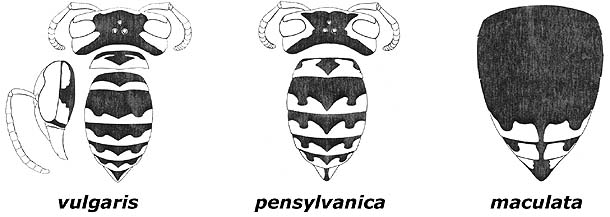
BUG OF THE MONTH: August 1994
Yellowjackets
Order Hymenoptera, family Vespidae
Copyright © 1994 by Sharon Collman
This article originally appeared in Scarabogram, Aug. 1994, New Series No. 172, p. 2.
Yellowjackets put caution in the mind of even the most fearless of collectors. These wasps, in the family Vespidae, are numerous and rather testy this time of year. But that can be the good news too, since they are abundant and can be an interesting study subject. There are three genera and eight species of yellowjackets in the Seattle area.
Technically, all these species are yellowjackets. We do not (yet?) have the true hornet, Vespa crabro. Maculata, pensylvanica and vulgaris are the most common (shown above in red).
The features for identifying these insects are fairly easy: a combination of the characteristics around the eye and base of the antenna, and the pattern on the gaster (abdomen).
The easiest yellowjackets to identify are the most common three (in
red, above). The bald-faced hornet is black with a white face and markings
on the tip of the abdomen. The western yellowjacket has a continuous yellow
dorsal ring around the eye (when viewed from above), and it tends to be mostly
yellow in color. The common yellowjacket is darker in body color and doesn't
have the yellow ring around the eye. See figures.

All the yellowjackets make a paper nest around the combs in which the eggs are laid and the larvae develop. The bald-faced hornet favors trees, rhododendrons, holly, and other bushes with sturdy branches to support the nest, although it will also build them under the eaves of houses. The common yellowjacket nests in stumps or logs, underground, in wall voids, and attics. The western yellowjacket usually nests underground, but sometimes in structures.
Keys to the other species with excellent drawings of the characters (including those above) may be found in Akre et al. (1981).
A neat experiment is to put out different kinds of foods (salmon cat food, boiled ham, chicken, etc.) and see which kind of yellowjacket comes to which foods. Is there a difference? You can also test the different kinds of traps that are available in the nurseries. For a fairly inexpensive booklet on these wasps get the Cooperative Extension bulletin, "Yellowjackets." It includes color photos and pictures for making homemade traps.
Paper wasps, genus Polistes, do not put a paper envelope around their nest. Colonies do not get very large, and the wasps are more docile and less nasty (unless the nest is near an entry door and you keep banging it, or near an open window and you sit on the wasp that has lost her way).
References
Akre, R.D., A.Greene, J.P.MacDonald, P.J.Landolt, and H.G. Davis. 1981. The yellowjackets of America North of Mexico. U.S. Department of Agriculture, Agriculture Handbook 552, 102 pp.
This page last updated 16 June, 2005